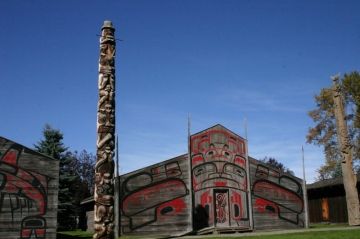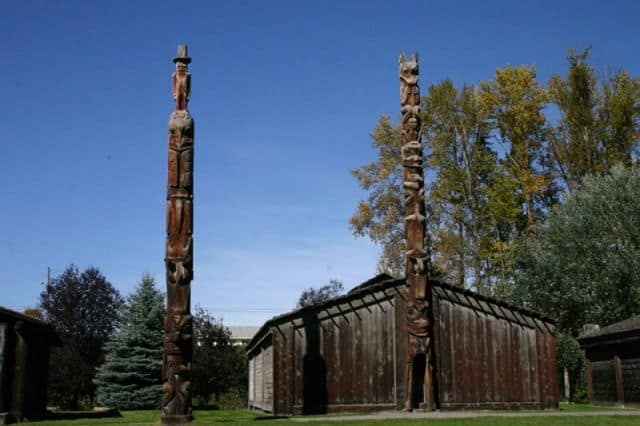Kasan First Nation Village

Park Amenities:
Kasan First Nation Village in Old Hazelton, British Columbia, Canada is a once-in-a-lifetime opportunity to visit with the history, art and culture of the Gitxsan First Nation people. The Kasan First Nation Village is located between the communities of Smithers and Terrace, British Columbia, Canada.
The village rests where, for many centuries, the Gitxsan First Nation People carved out a living on the Bulkley and Skeena Rivers. Today, site stands as a tribute to the culture, history and language of the Upper Skeena People.
The Kasan First Nation Village was created by the Gitxsan People and the rest of the Upper Skeena First Nation Villages to house an, ever increasing, amount of sacred artifacts. The collection became too large in 1959 so a building was erected as a museum to store the artifacts. The news spread of the museum and in 1970 the people decided to reconstruct an entire Gitxsan Village on the Bulkley River.
The Kasan First Nation Historic Village provides a great opportunity to view First Nation art including clothes, tools, jewelry, longhouses, Totem Poles and ceremonial masks. When entering the parking lot there are two large Totem Poles greeting all visitors. Each pole includes the figures and creatures important to the Gitxsan People.
The footpath from the parking lot leads visitors to another two shorter Totem Poles before entering the village. Continue along the footpath around the corner and a cedar canoe and a row of longhouses appear. The buildings are brightly painted in First Nation symbols with many buildings fronted by Totem Poles. The museum is the first building in the row of longhouses. Here you must pay admission to the village.
Admission is, either, a self guided tour of the outside grounds of the village and the museum or it is a guided interpretive tour which includes access to the inside of some of the longhouses. Some of the buildings in the village are traditional buildings used mainly for tourism purposes while most are actual working buildings used today for First Nation feasts, art school and traditional ceremonies.
After the museum is the workshop building also known as the 'House of Wood Carving' and is the home of the Kitanmax School of Northwest Coast Indian Art. The art building is closely followed by the studio which is part of the school and specializes in silk screen art.
The building in the middle of the village with the two towering Totem Poles is the 'Eagle House'. Followed next by the 'Fireweed House' which is an exact replica of the original museum built in 1959.
At the end of the row of longhouses, closes to the river, is the Wolf House and the Frog House. The Wolf House is a building for housing feasts. The Frog House is about the lifestyle of the Gitxsan People.
Visit Kasan First Nation Village in Old Hazelton, British Columbia, Canada
Address:





